Getting Our Students Excited About Science
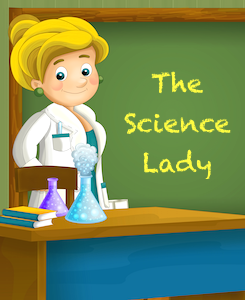 Don’t we all want to hear something like this in the hall?
Don’t we all want to hear something like this in the hall?
“I can’t wait for science class!”
So how does a science teacher get started in ways that encourage this level of engagement? Whether it’s the first weeks or even the first quarter, what are some of the possibilities?
I’d like to share a few of my ideas about some things teachers can do on the front end of the school year to get students intrigued, energized, and focused on science studies all year long.
There’s a reason we keep talking about “culture”
First and foremost, learning is all about relationships. If we keep that firmly in mind, our curriculum will follow and fall into place. Right away, we want to begin building a classroom culture of trust, friendship and shared excitement that will continue throughout the months ahead.
We can do this in many ways. This short excerpt from Ron Berger’s Leaders of Their Own Learning has some ideas. One of the co-authors, Libby Woodfin, wrote an article about culture-building for MiddleWeb (with some good how-to videos).
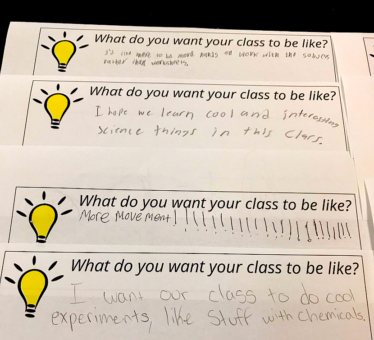
Growth mindset has become a catch-phrase in education, but there’s a reason for that. The powerful idea is that we get smarter and learn more when we believe we can and set out to prove it. Having this kind of mindset in place is huge as we work to get our students to think, talk, read, investigate and write like scientists.
Some questions we might ask to help our students keep an open, learning mind when it comes to science are:
- What did you learn today from today’s science lesson?
- What did you do to make science successful for you today?
- What did you do when you got stuck?
- What might you do differently next time?
One of my favorite all-time books is Oh, the Places You’ll Go by Dr. Seuss. I’m thinking parts of it (if not all of it) would make for a great visual read-aloud as we get science rolling in our classrooms. This is a book that even gets grown-ups inspired! (There’s also a version on YouTube read by John Lithgow.)
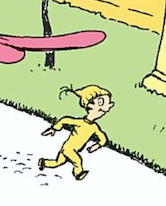
Use lots of “anchoring phenomena”
Science should also be fun. One way of making science relevant and fun is to engage students in the content through the use of anchoring phenomena. An anchoring phenomenon is “a puzzling event or process whose full explanation requires a wide range of science ideas to be coordinated with one another and with evidence.” There are some great online resources about anchoring phenomena developed as part of the NGSS rollout. Look at this searchable collection! Here’s a good middle school example – Chemical Reactions.
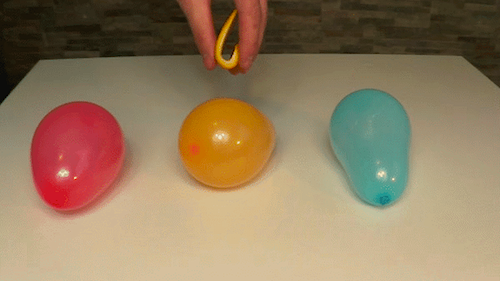
Click to see the action. Visit the NGSS page for teaching ideas.
A phenomenon (why use them in lessons?) that always brings a smile to my face is the “water hat.” I might show students the visual, let them giggle, and then ask them to draw an initial model to illustrate how they think this is possible.
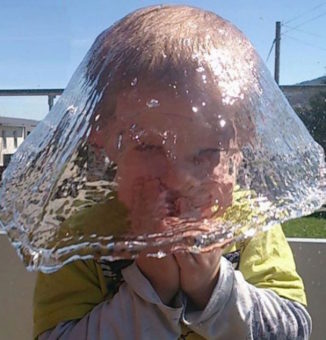
Modeling inquisitive science
Modeling what we hope for our students is also very important. If we want our students to be risk-takers and curious questioners, then we need to be creating many opportunities for real world exploration and discussion while planning our science instruction – opportunities that sometimes get us involved too!
Another one of my favorite videos that can help us all get a grasp in the real world is from the California Academy of Science. It’s called How Science Works (kind of like a pinball machine!). I think I’m on the right track because my colleague Cathy Boland also agreed.
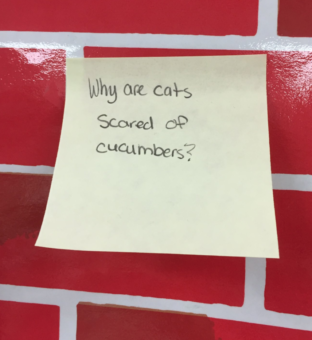
A few days later, 7th grade teacher Meg Richards (@frizzlerichard), posted a picture of her Wonder Wall. (Click on the tweet to go to her Twitter page.)
 The Science Notebook
The Science Notebook
Another important piece of learning and practicing science is data collection and recording. One way of doing this is through the use of a scientist’s notebook. It’s very important to promote the use of the science notebook by showing students how meaningful and relevant it can be.
One way is to have them share wonderings from their notebooks “to the wonder board” for others to muse about and possibly discuss. Another way to promote notebook writing is by sharing how scientists, young and old – in the past as well as today – have used their notebooks.
The books Notable Notebooks and Emmet’s Storm have wonderful examples of notebook entries. Here is an example from Emmet’s Storm, winner of the Children’s Book Council 2017 Best STEM Book Award. Author Ann Rubino is a retired science teacher who contributed to NGSS’s creation. Her character Emmet Roche is a middle school boy exiled to a country school in the late 19th century for too much wild speculation (smile).
We should talk about “Not yet”
I have also been thinking about the importance of “not yet” in a science classroom. Science is always changing because there are so many things we haven’t figured out. There is still so much left to learn about and discover, and students really benefit from coming to see that science isn’t all neatly tied up in a textbook – science is the pursuit of an ever-expanding, ever-changing understanding of the world in all its complexity. There will always be plenty we “don’t know yet” – plenty for young scientists to pursue.
As we begin our year in the classroom together, we have to teach our students it is important to ask questions, it is okay to make mistakes and to struggle a bit to figure out what is happening. One way we do this is by modeling risk taking, questioning, and productive struggle.
Here’s one of my favorite scientist quotes:
“Everyone is a genius, but if you judge a fish on its ability to climb a tree, it has lived its whole life believing it is stupid.” ~ Albert Einstein
It might be fun to discuss this quote with students. What is one of the world’s greatest scientists trying to tell us?
Please join in!
I am loving writing this blog, but I don’t want to be coming up with all the content. As we transition to the New Generation Science Standards and three-dimensional teaching and learning, there is so much to explore and discover.
I’m wondering what are some of your ideas, questions and concerns as we make this huge change. When I think about NGSS, I think it is more about how we teach than what we teach. What do you think?
I hope your year is off to a scintillating scientific start. See you in November.

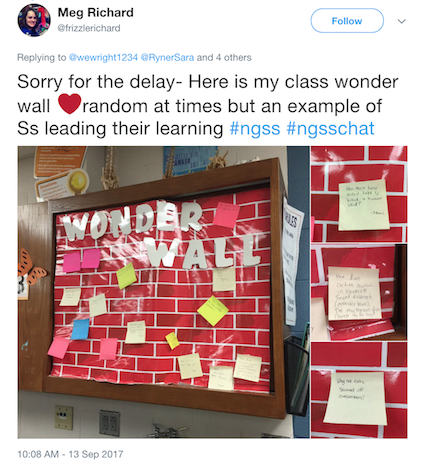
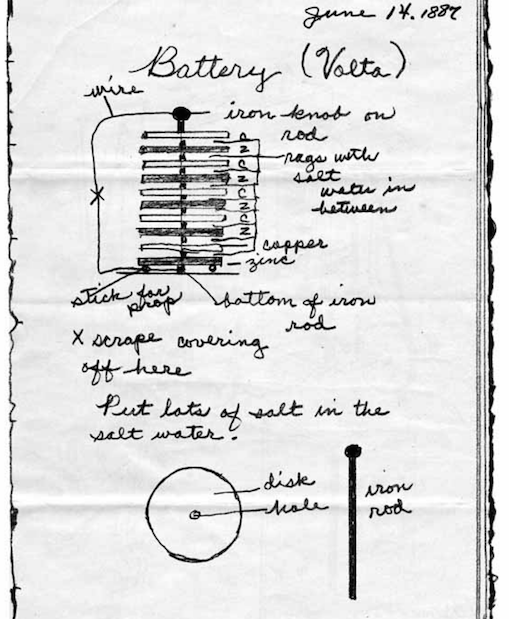





























Great info, Kathy! I knew you were going to be a top-notch and authentic science source when you started this post by saying “Learning is all about relationships.” I so agree that a culture of trust is a critical part of science (or any subject.) I also like the way you work in the NGSS – thanks for that! I look forward to keeping up with you and your posts!
Great post and I appreciated all of the links to additional resources! I wondered if both Kathy and Anne might be able to direct me to exemplar STEM lessons in grades 1-6 that align well to the criteria Anne lists in her book STEM by Design. I’ve been enjoying that book and the examples are very helpful. I’m trying to view and collect as many exemplary video lessons as I can to better educate myself about STEM and then share the examples with me students. Any recommendations you can share will be much appreciated! Thanks!